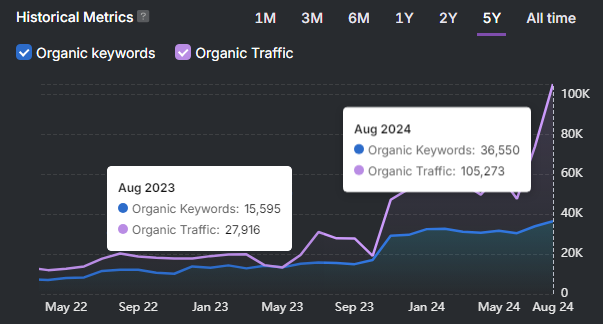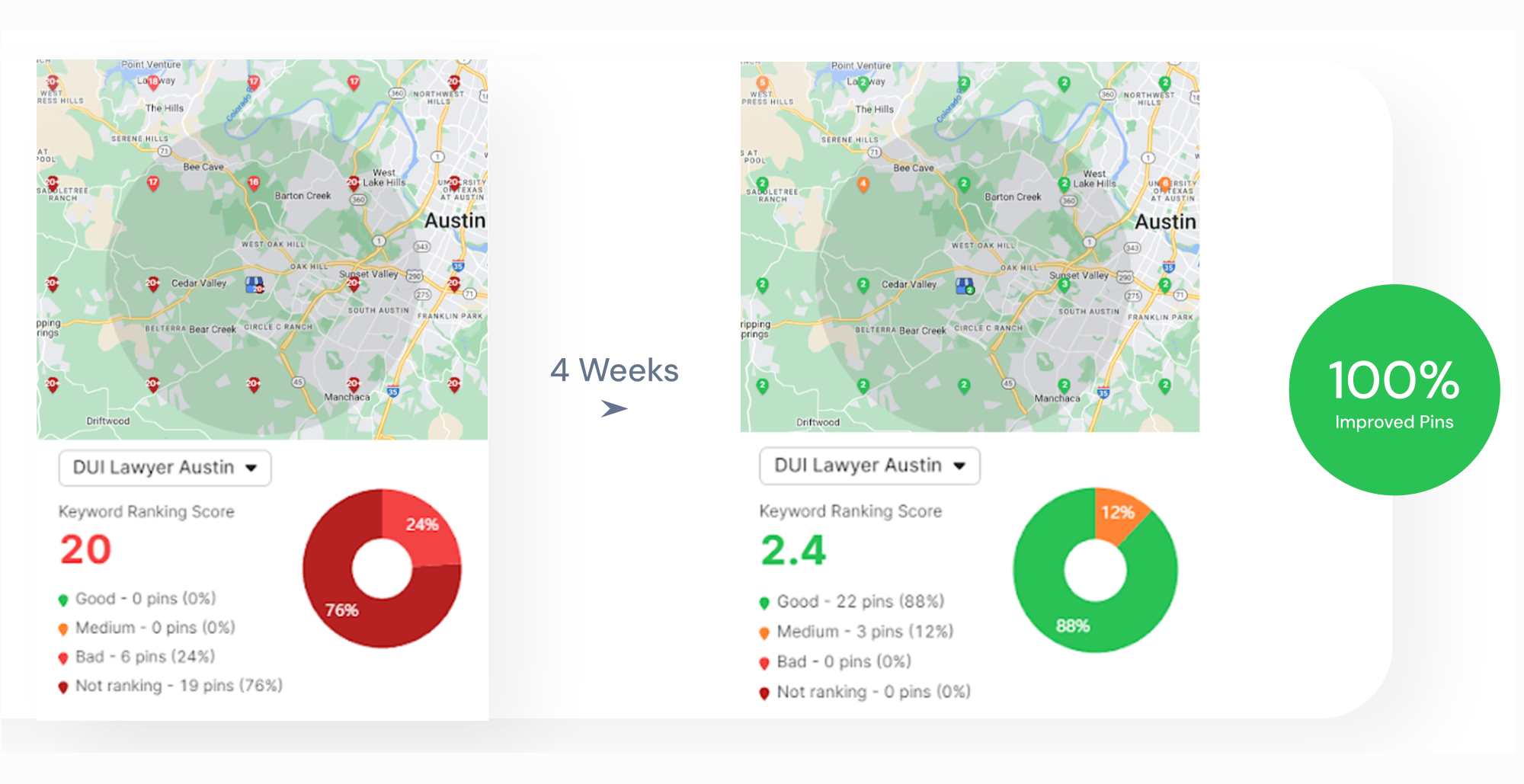Voice search optimization refers to optimizing a website’s content and structure to make it more discoverable and relevant for voice searches. Voice search optimization works by tailoring your website content to match the way people naturally speak when interacting with voice assistants like Google Assistant, Siri, and Alexa.
The importance of voice search optimization cannot be overstated in today’s digital world. Optimizing for voice search helps businesses improve visibility, increase user experience, and boost the chances of ranking for featured snippets. The two voice search best practices are using conversational, long-tail keywords and focusing on local SEO. The voice search best practices help businesses stay ahead of the curve and make sure their content remains accessible and relevant in the age of voice-driven search.
What is Voice Search Optimization?
Voice search optimization is the process of adapting your digital content to be more easily discoverable and accessible through voice-activated searches. Voice search optimization has become an important aspect of digital marketing and SEO strategy. In fact, studies show that 71% of consumers prefer to conduct queries by voice rather than typing.
Voice search SEO focuses on catering to conversational, long-tail search queries and making sure that a site provides direct, clear answers to frequently asked questions. Voice SEO includes using natural language, targeting local searches, and aiming for featured snippets.
The primary goal of voice search and SEO is to be selected or spoken by a voice search device when users perform a voice search. Optimizing for voice search helps your website rank higher in search results when users perform searches through voice assistants, like Siri, Alexa, Google Assistant, or others.
What is the History of Voice Search Technology?
The history of voice search technology traces back to the early 1950s with Bell Laboratories’ creation of “Audrey,” which was a simple system that could recognize spoken digits. The 1960s brought IBM’s “Shoebox,” capable of understanding basic spoken commands, while DARPA’s research in the 1970s expanded vocabularies to over 1,000 words.
The 1980s-1990s marked significant progress with the introduction of statistical methods and hidden Markov models. Dragon Systems released the first consumer speech recognition products during this period, making the technology available to the public for the first time.
The real turning point came in the 2000s when improvements in computing power and machine learning led to more accurate and accessible voice recognition. In 2011, Apple launched Siri, the first widely adopted voice-activated assistant, which brought voice search into the mainstream. Google followed suit with Google Now in 2012, and Microsoft introduced Cortana in 2014. Amazon’s Alexa, launched in 2014 as part of the Echo smart speaker, further popularized voice interfaces in everyday life.
The rise of smart devices and virtual assistants has since driven the rapid adoption of voice search. Google Assistant, launched in 2016, took voice interaction a step further by integrating contextual understanding and AI-driven responses. Today, voice search is a key feature across platforms and devices, from smartphones to smart home systems, and continues to evolve with the integration of generative AI and real-time conversational models.
What is the Impact of Voice Search Optimization on Search Engine Rankings?
Voice search optimization significantly impacts search engine rankings by aligning content with how users interact with voice-enabled devices. As search engines increasingly prioritize user intent and experience, content that is conversational, context-aware, and provides clear, direct answers tends to rank higher. Additionally, pages optimized for voice search are more likely to be featured in position zero, or featured snippets, which are often the primary results read aloud by voice assistants. The increased visibility from getting featured in snippets improves a site’s authority and drives more organic traffic.
Voice search heavily emphasizes mobile usability and site speed, which are two critical ranking factors in modern SEO. Since most voice queries are made on smartphones and smart devices, websites that are mobile-friendly and load quickly are more likely to rank well. Furthermore, the local intent behind many voice searches has elevated the importance of local SEO. Businesses that optimize for “near me” queries, maintain up-to-date local listings, and incorporate geographic keywords are better positioned to capture traffic from voice-enabled searches.
Voice search is reshaping traditional SEO practices by shifting the focus from short, keyword-heavy phrases to more natural language queries. Instead of targeting isolated keywords, content strategies now incorporate long-tail keywords and conversational phrasing that mimics how people speak. Additionally, SEO professionals are adapting by creating content that answers specific questions, using structured data to help search engines understand context, and prioritizing user experience across devices.
What is the Importance of Voice Search Optimization?
Voice search optimization in digital marketing is increasingly important as it aligns with the growing trend of users interacting with search engines through voice commands. As more users turn to voice-enabled devices like smartphones, smart speakers, and virtual assistants, businesses must adapt their SEO practices to cater to this growing trend and remain accessible and competitive.
The benefits of voice search optimization are listed below.

- Increased Visibility in Search Results. Optimizing for voice search can help your content get featured in featured snippets.
- Improved User Experience. Voice search demands clear, concise, and conversational content, which naturally improves readability, accessibility, and overall content quality.
- Improved Local SEO Performance. Since voice searches often include local intent, optimizing for these local queries helps you rank higher for location-specific voice searches, driving more foot traffic and conversions.
- Competitive Advantage. As not all businesses are fully optimized for voice search yet, early adopters gain an edge over competitors. The competitive advantage is especially beneficial in industries where speed and convenience matter, like local services, food delivery, or e-commerce.
- Higher Engagement and Conversion Rates. Voice searches are often intent-driven, with users closer to making a purchase or decision. Delivering direct, relevant answers to these queries can significantly increase engagement and conversions.
With the rise of smart speakers and mobile assistants, voice search is expected to grow and become more popular as a medium for getting information. In fact, voice searches are predicted to account for more than 50% of all internet searches by 2025. Investing in SEO for voice search today makes sure your brand is future-ready as consumer behavior continues to shift.
How Does Voice Search Work?
Voice search works through a combination of speech recognition, natural language processing (NLP), and artificial intelligence (AI) to convert spoken queries into text and provide relevant results. The voice search optimization process begins when a user speaks into a voice-enabled device, such as a smartphone, smart speaker, or virtual assistant. The voice-enabled device captures the audio through its microphone and uses speech recognition technology to transcribe the spoken words into text.
The natural language processing algorithms analyze the converted text’s meaning, context, and intent. Unlike traditional search engines, voice search systems are designed to understand more conversational language, including colloquialisms, sentence structure, and tone.
After processing the query, the voice search system matches it with the most relevant search results. The voice search system often pulls concise answers from featured snippets, knowledge graphs, or local business information. The voice assistant then delivers the response in a spoken format, guaranteeing a quick and user-friendly experience. Over time, voice search systems continue to learn and improve, becoming more adept at understanding various accents, dialects, and conversational styles.
How to Optimize a Website for Voice Search?

There are 9 ways to optimize a website for voice search and make sure it is well-positioned to meet the growing demand for voice-driven search experiences. The 9 voice search optimization tips are listed below.
1. Use Conversational, Long-Tail Keywords.
Conversational, long-tail keywords are longer and more specific phrases that mimic the natural way people speak when using voice search. Long-tail keywords generally contain more than three words and often include question-based or location-specific terms. For example, “Where can I find the best coffee shop near me?”
Using conversational, long-tail keywords is essential for voice SEO because voice queries tend to be more natural and specific than typed ones. People are more likely to ask full questions aloud, such as “What’s the best way to treat a cold naturally?” rather than saying “natural cold treatment.” Optimizing for conversational, long-tail keywords helps your content appear in voice search results, particularly in featured snippets, which are often used by voice assistants to deliver quick answers.
To use conversational, long-tail keywords in your voice search SEO strategy, start by researching the kinds of questions your audience is likely to ask and creating content that addresses those queries directly. Write in a conversational tone that closely mirrors how people speak in everyday life. Adding a Frequently Asked Questions (FAQs) section to your pages can help directly target common voice search phrases. You can leverage tools like Search Atlas’s Keyword Magic Tool or Google’s “People Also Ask” to find long-tail, question-based phrases.
The Search Atlas Keyword Magic Tool serves as a powerful asset in discovering conversational and long-tail keywords commonly used in voice queries. Simply enter a seed keyword, select the country you want to target, and click search. The Search Atlas Keyword Magic Tool then generates a list of related keywords you can choose from, along with key metrics such as search intent, monthly search volume, traffic potential, keyword trend, and competitor pressure.

2. Optimize for Featured Snippets.
Featured snippets are short, text excerpts that appear at the top of Google’s search results, often in a box format. Featured snippets aim to quickly answer a user’s question without requiring them to click through to a website. Featured snippets are commonly pulled from high-quality web pages and may appear as paragraphs, lists, or tables.

Optimizing for featured snippets is especially important for voice SEO because voice assistants typically read them aloud as the top response. In fact, studies show that approximately 40-60% of voice search answers come from featured snippets. Optimizing for featured snippets significantly increases your chances of becoming the voice assistant’s answer of choice, improving visibility, driving more organic traffic, and boosting your authority in search results.
The best practices for optimizing your content for featured snippets are listed below.
- Format your answers in clear, concise paragraphs of 40-60 words that directly address the query.
- Use proper heading tags like H2 or H3 to break up content and organize questions and answers logically.
- Present your content using bullet points, numbered lists, or short paragraphs for easier scanning and indexing.
- Include a comprehensive set of related questions and answers on a single page to increase snippet opportunities.
- Place a concise definition of the key concept near the top of the page, ideally in the first paragraph.
- Analyze current featured snippets for your target keywords to understand what format and information Google prefers.
- Implement structured data (schema markup) to help search engines understand the context of your content more accurately.
Optimizing for featured snippets has become an essential component of modern SEO strategy, particularly for voice search success. Securing the “position zero” placements increases your visibility in traditional search results and significantly improves your chances of being the sole answer provided by voice assistants.
3. Prioritize Local SEO.
Local SEO refers to the process of optimizing your online presence to attract more business from relevant local searches. Local SEO focuses on improving visibility for location-specific searches, making your business more prominent when users search for products or services in a particular geographic area. Local SEO strategies include optimizing your website, online listings, and content to appear in local search results, map packs, and location-based queries.
Local SEO plays a huge role in voice SEO, as many voice searches are location-based. In fact, voice searches are three times more likely to be location-based than text searches, with phrases like “near me,” “open now,” or specific neighborhood mentions being extremely common.
Prioritizing local SEO gives local businesses a much higher chance of being featured in voice search results, which can lead to increased foot traffic, phone inquiries, website visits, and ultimately, higher conversion rates. Additionally, focusing on local SEO improves the visibility of local businesses in Google Maps, boosts their credibility through local reviews, and strengthens their presence in local directories.
The best practices for optimizing for local SEO are given below.
- Make sure your Google Business Profile (GBP) is complete, accurate, and frequently updated.
- Leverage other local directories to make sure your local business is shared by different voice assistants.
- Use local keywords such as city names and neighborhood references throughout your content.
- Include your business’s name, address, and phone number (NAP) consistently across all platforms.
- Collect positive customer reviews on local directories to improve trust and relevance.
- Create content that answers local questions, such as “best [service] in [location].”
- Include proximity-based keywords and phrases like “near me,” “in [city name],” or “serving [area]” in your content, meta descriptions, and headers.
- Develop dedicated pages for each physical location with unique content, embedded Google Maps, location-specific testimonials, and relevant local information.
- Add local business schema to your website to help search engines understand your location, business type, operating hours, and other critical local information.
The Search Atlas SEO Software Platform offers a comprehensive set of tools designed to elevate your local SEO strategy. The Search Atlas Local SEO Heatmap Tool helps you uncover the most valuable location-based keywords for your business by visually highlighting which search terms are driving visibility in your target geographic areas. The Search Atlas GBP Automations Tool provides clear, actionable recommendations to optimize your GBP and increase local rankings. Together, these tools streamline local SEO management and improve your visibility where it matters most.

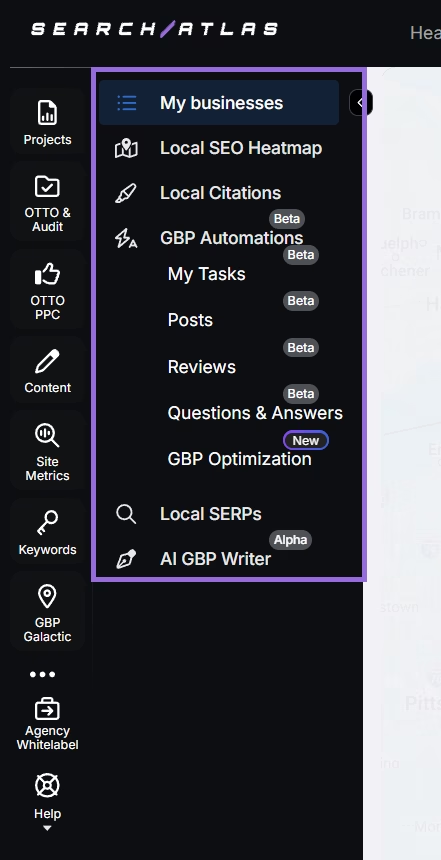
4. Improve Technical SEO.
Technical SEO refers to the process of optimizing your website’s backend structure and foundational code to help search engines effectively crawl, index, and rank your pages. Technical SEO includes elements like site speed, mobile-friendliness, secure connections (HTTPS), structured data, and XML sitemaps.
Technical SEO is particularly important when it comes to voice SEO, as voice search tends to favor fast, mobile-optimized, and well-structured websites. Since most voice searches are performed on mobile devices or smart speakers, search engines prioritize pages that load quickly, are easy to navigate, and provide structured data for quick answers. A technically optimized site improves the likelihood of being selected as a voice search result by making sure your content is both discoverable and accessible.
To improve your technical SEO, start by increasing your page loading speed through tactics like compressing images and minimizing code. Making sure that your site is mobile-friendly and responsive across all device types is another crucial step. Secure your website with HTTPS to build user trust and meet Google’s ranking preferences.
Additionally, implement structured data using schema markup so that search engines can better understand and categorize your content for relevant voice queries. Check routinely for crawl errors, update your XML sitemap to reflect your current site structure, and address any issues that could hinder indexing. Finally, optimize for Google’s Core Web Vitals, which are metrics that assess user experience based on speed, responsiveness, and visual stability, to further boost performance.
The Search Atlas Site Auditor Tool helps improve technical SEO by thoroughly auditing the overall SEO health of your website and providing actionable recommendations. Simply create a project, run an audit, and navigate to the “Issues” section. The Search Atlas Site Auditor Tool then presents a comprehensive list of identified issues, including on-page, off-page, and technical issues, which may be affecting your site’s performance.
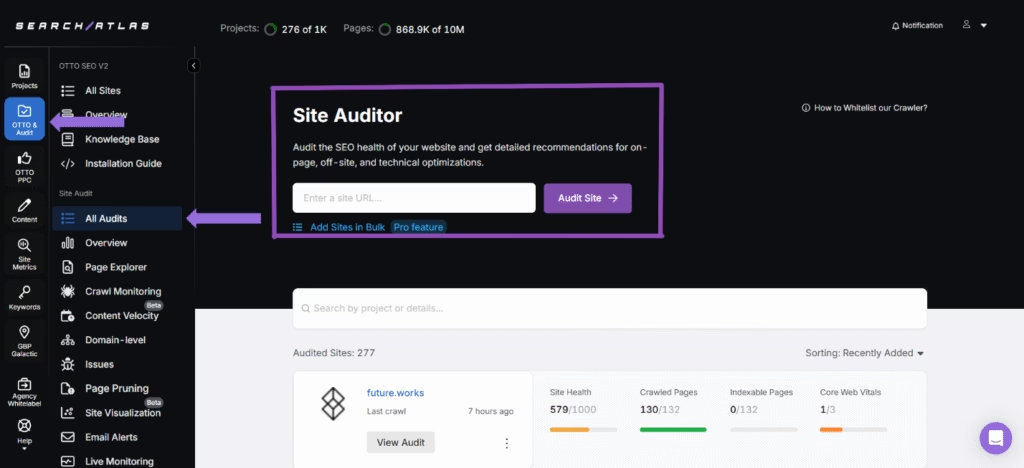
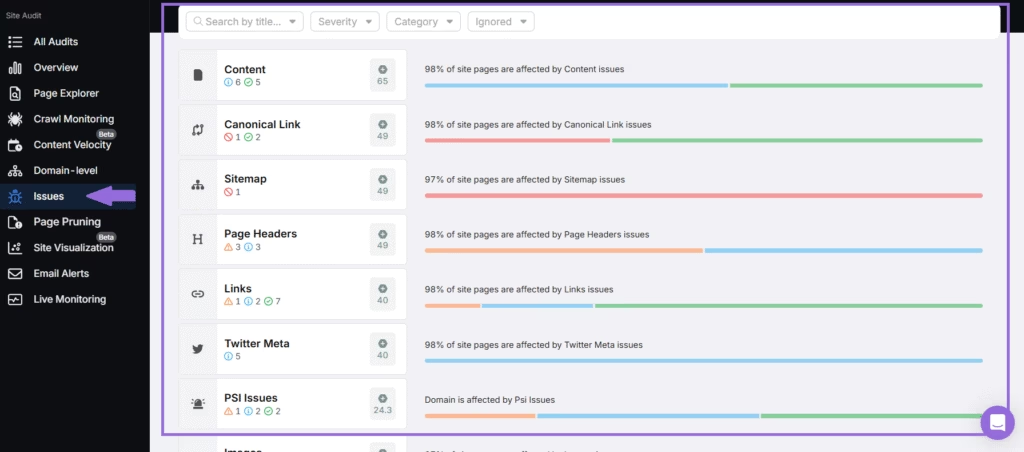
The Search Atlas Site Auditor Tool makes the auditing process even easier by allowing you to view issues by their title, category, and severity. Just navigate to the top of the dashboard, click on “Select by Title,” “Severity,” “Category,” or “Ignored,” and include or select the preferred options. Through this structured approach, the Search Atlas Site Auditor Tool helps you save time and makes sure that your SEO efforts are focused on the most critical areas for improvement.

5. Make Your Website Mobile-Friendly.
Making your website mobile-friendly means designing and optimizing your site so that it displays and functions properly across all mobile devices, including smartphones and tablets. A mobile-friendly website makes sure that users have a seamless browsing experience, with easy navigation, readable text, quick loading times, and minimal need for zooming or horizontal scrolling.
Mobile-friendliness directly impacts voice SEO since most voice searches are performed on mobile devices. Search engines, including Google, prioritize mobile-optimized websites in their rankings, especially when delivering voice search results. Google’s mobile-first indexing means that if your site is not mobile-friendly, it is less likely to rank for voice queries, resulting in missed opportunities to capture organic traffic. Additionally, a mobile-optimized site supports faster load times, better usability, and increased accessibility, all of which are crucial factors that influence whether a search engine selects your page as the best answer for a voice query.
To make your website mobile-friendly, focus on using responsive web design so that your layout automatically adjusts to fit different screen sizes. Simplify your navigation to make it easy for users to find what they need without endless scrolling or clicking. Optimize images and other media files to guarantee fast loading speeds without sacrificing quality.
Additionally, use large, legible fonts that are easy to read on small screens and make sure that buttons and links are well-sized for easy tapping. Regularly test your site on various mobile devices to identify and fix any usability issues that could affect user experience.
A mobile-friendly website forms the foundation for successful voice search optimization. By prioritizing responsive design, speed, and usability, you create a better experience for both users and search engines, ultimately improving your chances of appearing in voice search results.
6. Use Structured Data (Schema Markup).
Structured data, often called schema markup, refers to a standardized format for providing information about a webpage and classifying its content. Structured data is a semantic vocabulary of tags (or microdata) that you can add to your HTML to improve how search engines read and represent your page in search results. Schema markup creates a detailed description, commonly known as a rich snippet, that appears in search results and helps search engines understand the context and relationships of the information on your website.
Structured data plays a crucial role in voice SEO since voice assistants rely heavily on quick, clear, and structured information to answer queries accurately. Marking up your content properly makes it easier for search engines to extract relevant details and deliver precise voice search responses.
Websites that implement structured data effectively are more likely to be pulled into voice search answers, especially for question-based queries and local search results. Additionally, implementing structured data improves your chances of appearing in featured snippets and knowledge panels, which are frequently used as sources for voice search responses.
The best practices for implementing structured data are given below.
- Add schema markup to essential elements like articles, FAQs, products, events, reviews, and local business information.
- Implement the schema types most relevant to your business and content.
- Use the BreadcrumbList schema to help voice assistants understand your site’s hierarchy and navigation structure.
- Implement speakable markup to identify sections of content that are particularly suitable for text-to-speech applications.
- Regularly test your structured data using Google’s Rich Results Test to identify and fix any errors.
- Keep your markup up-to-date with any changes to your content or Google’s schema guidelines.
The Search Atlas Structured Markup Generator Tool is designed to help you create accurate and comprehensive JSON-LD markups for your website. The Search Atlas Schema Markup Generator Tool instantly generates all the required item properties and more, making sure that your structured data adheres to Schema.org standards. After generating the markup, you can click on the “Test” icon under the generated code to test it using Google’s Rich Results Test to validate and preview how your structured data will appear in search results. The Search Atlas Schema Markup Generator Tool simplifies the process of adding structured data to your website, helping improve your site’s visibility and eligibility for improved search result features like rich snippets.
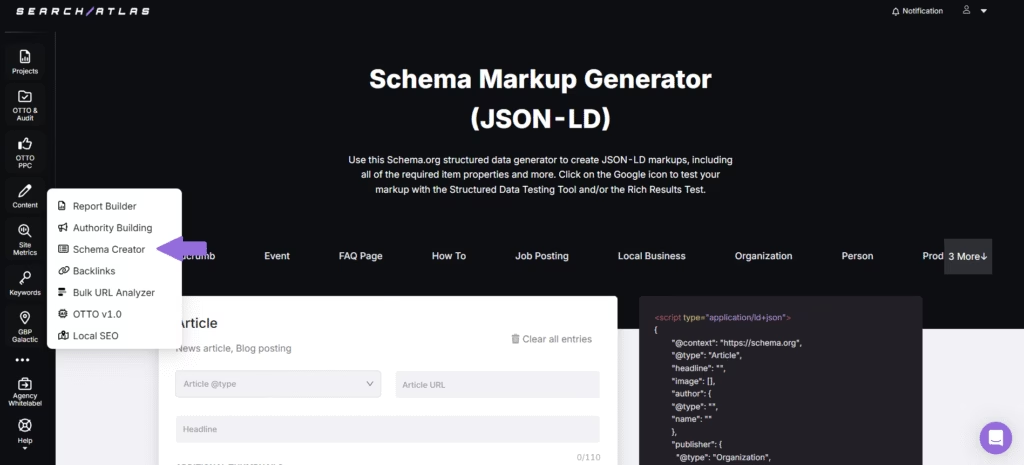
7. Create Voice-Friendly Content.
Voice-friendly content refers to writing and structuring information in a way that aligns with how people naturally speak when using voice commands. Voice-friendly content is clear, concise, easy to understand, and structured to provide direct answers quickly.
Creating voice-friendly content is essential for voice SEO because search engines prioritize content that closely matches user intent and conversational tone. Since voice assistants seek out quick, accurate responses, having content that mirrors spoken language increases the chances of being selected as the top answer. Pages that focus on answering common questions, using natural phrasing, and providing information in an easily digestible format perform better in voice search results.
To create voice-friendly content, focus on answering common questions clearly and within the first few sentences to quickly address user intent. Use a conversational tone that matches how people naturally speak, making the content sound more relatable and engaging. Structure your writing with short paragraphs and bullet points to improve scannability.
Additionally, incorporate trigger words like “how,” “what,” “where,” and “why” to align your content with typical voice queries. Avoid using jargon or complex language to keep your content simple and easy to understand.
The Search Atlas Content Genius Tool is an innovative tool that helps you create high-quality, voice-friendly content using Artificial Intelligence. Simply enter your topic, related keywords, and target country, and within minutes, the Search Atlas Content Genius Tool generates a high-quality, well-optimized article. You can click into the generated article to edit it and further improve its on-page SEO.
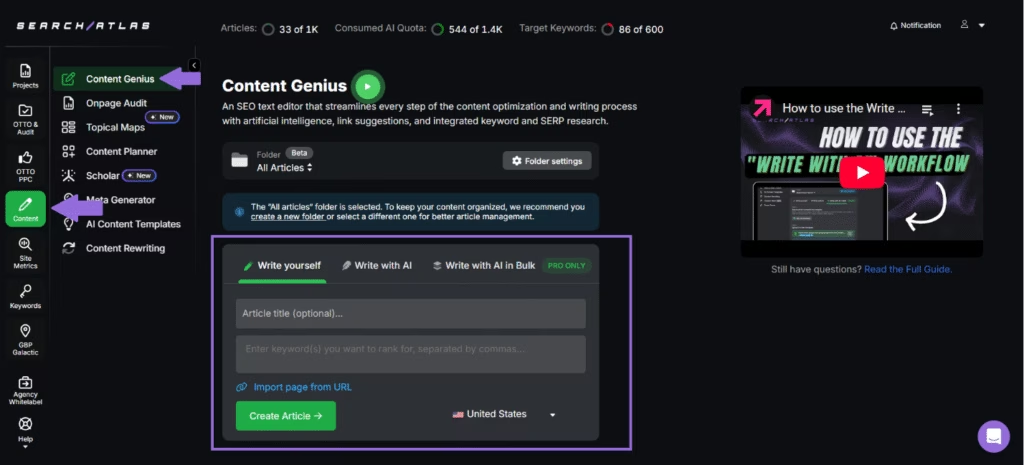
The Search Atlas Content Genius Tool works by conducting an in-depth competitor analysis by searching your target keywords on Google and analyzing the top 20 ranking pages. The Search Atlas Content Genius Tool then provides valuable insights into key SEO metrics such as Domain Rating (DR), content score, schema usage, internal and external linking strategies, heading structures (H1, H2, H3), and word count.
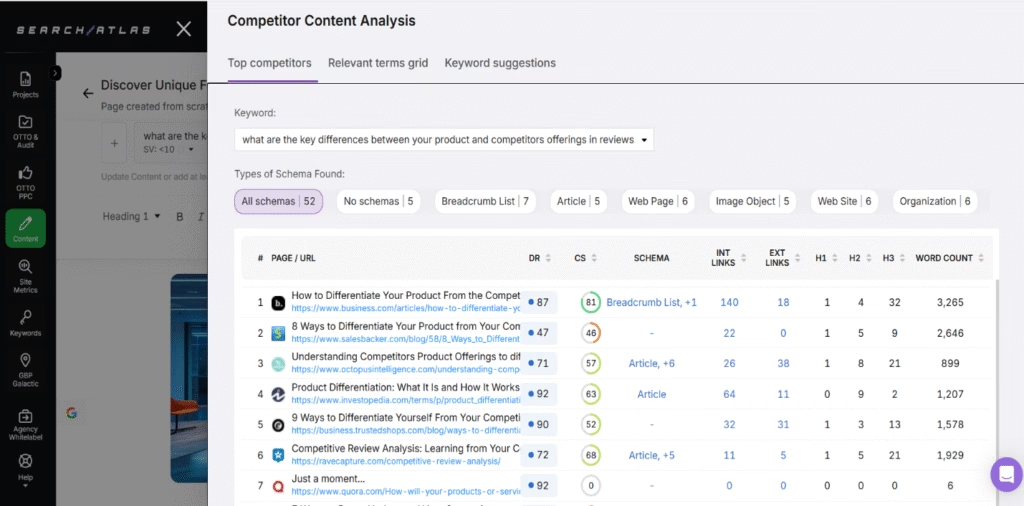
Additionally, the Search Atlas Content Genius Tool provides a bird-eye view of “Relevant Terms” in a grid format, which presents NLP and semantic terms extracted from top-ranking pages to help you understand the important keywords, concepts, and phrases competitors use while showing how frequently your content incorporates these elements.
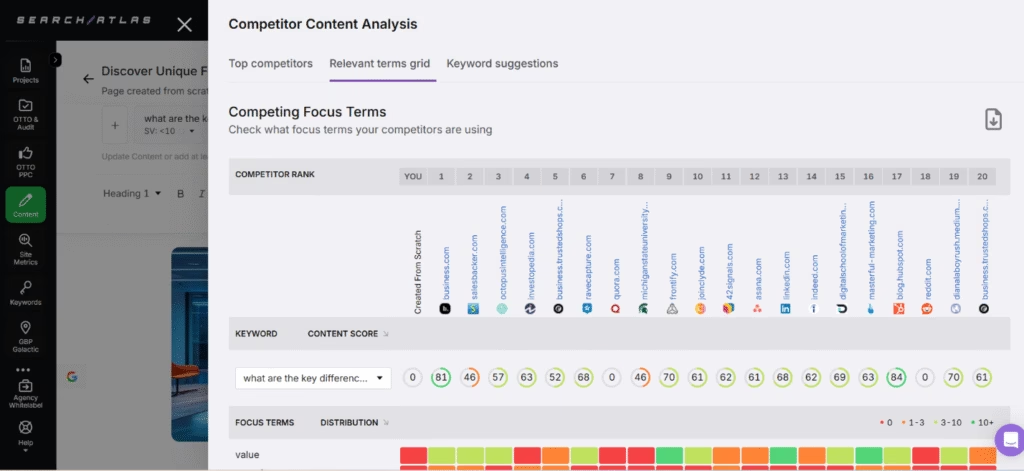
8. Improve Accessibility.
Accessibility refers to the practice of designing and developing websites so that all users, including those with disabilities, can easily access, navigate, and interact with your content. Accessibility involves optimizing elements like text readability, proper use of headings, alternative text for images, and keyboard navigation. Accessible websites are designed to work seamlessly with assistive technologies like screen readers, voice recognition software, and alternative input devices.
Improving website accessibility directly supports voice SEO because both focus on making content usable without traditional visual interfaces. When a website is accessible, it becomes easier for voice assistants and search engines to interpret and deliver your content accurately. Accessibility best practices broaden your audience and improve your site’s SEO performance by aligning with search engines’ preferences for user-friendly websites.
The tips to improve accessibility are given below.
- Use clear, descriptive headings and properly structured HTML to help both users and search engines understand page content.
- Add alt text to all images to make sure screen readers and voice-enabled devices can describe visual content.
- Make sure your site is fully navigable using a keyboard to support users who cannot use a mouse.
- Use ARIA (Accessible Rich Internet Applications) attributes to improve the semantics of page elements where HTML5 semantic elements are not sufficient.
- Choose fonts and colors that improve readability and contrast for visually impaired users.
- Provide transcripts for audio and video content to make multimedia accessible to everyone.
- Use meaningful link text that describes the destination rather than generic phrases like “click here” or “read more.”
- Regularly audit your site with tools like Axe or Lighthouse to identify and resolve accessibility issues.
- Follow Web Content Accessibility Guidelines (WCAG) to maintain a high standard of accessibility across your site.
Improving your website’s accessibility fosters a more inclusive user experience and strengthens your visibility in voice search results. By prioritizing accessibility for SEO, you create a site that serves all users better while aligning with the evolving demands of voice-enabled search technologies.
9. Monitor Performance.
Monitoring performance in the context of voice SEO refers to the systematic tracking, measurement, and analysis of how well your website and content perform in voice search results. Performance monitoring with regard to voice SEO involves collecting data on voice search rankings, user engagement metrics, technical performance indicators, and conversion rates related to voice queries.
Monitoring performance is crucial for voice SEO because voice search is rapidly evolving. Regular performance checks allow you to identify what strategies are driving traffic from voice searches and where improvements are needed. For instance, if certain pages are frequently featured in voice results, you can study what made them successful and replicate that success elsewhere.
Additionally, performance monitoring helps make sure your site continues to meet critical factors like site speed, mobile-friendliness, and structured data usage, which are essential for being favored in voice search results.
To monitor performance, consistently track voice search traffic and keyword rankings to understand shifts in user behavior. Set up reports in Google Search Console to monitor mobile usability and site errors. Analyze the performance of FAQ pages and featured snippets since they often contribute to voice search results. Use tools like Search Atlas SEO Software Platform to find new voice-friendly keyword opportunities. Additionally, regularly audit your technical SEO elements to make sure your website remains fast, secure, and crawlable.
Monitoring your website’s performance is not a one-time task but an ongoing process. Staying updated on how your voice search optimization efforts are performing allows you to adapt, improve, and maintain a strong presence as voice search continues to grow.
How to Perform a Voice Search Optimization Audit?
There are 10 steps involved in performing a voice search optimization audit to help you identify gaps and opportunities to improve your site’s performance in voice-driven queries. The 10 steps to perform a voice search optimization audit are outlined below.
- Analyze the traffic. Look into your website’s current traffic sources and check how much is coming from voice searches. Analyzing your website’s current traffic helps you set a baseline and understand the areas you need to improve.
- Review the keyword strategy. Make sure you are targeting conversational, long-tail keywords that match how people speak. Focus on question-based and natural-sounding phrases.
- Evaluate the content. Check if key pages directly answer common questions in your industry and consider creating dedicated FAQ sections for high-value topics. Assess how quickly your content delivers answers and whether the information is structured for easy extraction by voice assistants.
- Audit mobile-friendliness. Use tools like Google’s Mobile-Friendly Test to assess how your site performs on smartphones and tablets. Complement the test with real-world testing across various devices to guarantee a truly responsive design.
- Measure page speed. Test your page loading times using Google PageSpeed Insights or GTmetrix. Fast-loading websites offer a better user experience and are more favored by search engines in voice search rankings.
- Check structured data. Check your current schema markup implementation to confirm you have properly deployed structured data for business information, FAQs, products, events, and other relevant content types. Monitor whether your structured data successfully generates rich results in search, as these often correlate with voice search performance.
- Inspect local SEO. Confirm that your GBP is updated and your NAP information is consistent across all listings. Review your local review strategy, including current ratings, review volume, recency, and your process for responding to both positive and negative reviews.
- Analyze featured snippet performance. Identify which of your pages currently earn featured snippets and analyze their structure and content patterns to understand what is working. Find high-value featured snippet opportunities you are not capturing by researching question-based queries in your industry. Study competitors’ featured snippet strategies, focusing on their content formatting, word count, and information presentation.
- Verify accessibility. Check that your website is accessible to all users, including those with disabilities. Conduct a comprehensive WCAG compliance check, paying particular attention to factors that affect both accessibility and voice search performance.
- Set up ongoing monitoring systems. Implement tracking for voice search-specific metrics that go beyond traditional SEO measurements, including featured snippet tracking and question-based query performance. Schedule regular voice search testing across different devices and assistants to monitor real-world performance. Establish consistent review cycles for voice search performance that align with your broader digital marketing calendar.
What are the Best Voice Search Optimization Tools?
There are several voice search optimization tools to help you streamline the process of making your website voice-friendly. Free tools like Answer the Public help visualize the questions people are asking online, making it easier to identify conversational, long-tail keywords for voice optimization. Additionally, Google’s People Also Ask and Google Trends are helpful tools for discovering trending questions and topics that align with how users naturally speak.
Google Search Console helps you monitor your site’s voice search performance by tracking voice search queries, impressions, and identifying mobile usability issues that could affect voice-driven traffic. Meanwhile, Google Analytics provides valuable insights into how users from voice search sources interact with your site across different devices, helping you better understand and optimize the user experience.
Paid tools like the Search Atlas SEO Software Platform offer a more specialized and in-depth approach to voice search optimization. The Search Atlas Keyword Magic Tool helps you identify relevant conversational and question-based phrases, allowing you to tailor your content strategy specifically for voice queries. The Search Atlas Local SEO Tools enable you to focus on location-based keywords and improve your visibility for “near me” searches, which are highly common in voice queries. Additionally, the Search Atlas SEO Software Platform helps make sure your site is optimized for speed, mobile usability, and technical SEO, provides detailed structured data recommendations, and assists in generating high-quality, voice-friendly articles optimized for SEO.
Does AI improve Voice SEO?
Yes, AI does improve voice SEO by helping businesses create more natural, conversational, and highly targeted content that aligns with how people speak during voice searches. AI SEO tools can analyze large sets of search data to identify common voice search patterns, such as question-based queries and long-tail keywords, allowing content creators to optimize their pages accordingly.
Additionally, AI-driven platforms can suggest better content structures, provide semantic keyword recommendations, and even simulate how voice assistants interpret queries, making sure that content is more likely to be picked up and read aloud by voice-enabled devices.
As AI continues to advance, the connection between AI and voice search optimization strengthens, making it easier for businesses to optimize their content for voice search.
How Does the Voice Search Optimization Market Look?
The voice search optimization market is experiencing significant growth, driven by the widespread adoption of voice-enabled devices and advancements in artificial intelligence. As of 2023, the global voice search market was valued at approximately $3.05 billion and is projected to reach $13.88 billion by 2030, growing at a compound annual growth rate (CAGR) of 23.8%.
The expansion of the voice search optimization market is fueled by the increasing use of smart speakers, smartphones, and other voice-activated devices. In fact, the smart speaker market alone is projected to grow from $14.36 billion in 2024 to $19.01 billion in 2025, reflecting a CAGR of 32.4%.
Additionally, AI plays a crucial role in the growth of the voice search optimization market, improving voice recognition accuracy and enabling more natural, conversational interactions. Google voice search optimization, for instance, leverages AI algorithms like BERT to better understand and process user queries, improving the relevance of search results. As AI continues to evolve, optimizing for voice search is becoming a vital part of staying visible and competitive in the digital marketing field.
How Can Voice Search Optimization Be Integrated Into Digital Marketing Strategies?
Voice search optimization can be easily integrated into digital marketing strategies by aligning content creation, SEO efforts, and user experience design with the way people naturally speak. Focus on using conversational, long-tail keywords across website content, blog articles, and landing pages to mirror the natural, question-based language of voice queries. Developing FAQ sections, optimizing for local SEO with geographic keywords, and improving mobile-friendliness and site speed are essential to meet the demands of voice search users. Structured data should be incorporated to help search engines easily pull information for rich snippets.
Additionally, leveraging AI-driven analytics tools can provide deeper insights into voice search trends, allowing you to refine your strategies dynamically. By aligning voice search optimization with broader SEO, content marketing, and paid media efforts, businesses can improve discoverability, increase user experience, and stay ahead in an era where voice search is projected to dominate. For maximum impact, brands should experiment with emerging platforms, like smart speakers and in-car voice assistants, to tap into new audience segments.
How to Start a Voice Search SEO Agency?
Starting a voice search SEO agency requires a deep understanding of both traditional SEO practices and the unique demands of optimizing for voice-enabled devices. First, build strong expertise in areas like conversational keyword research, mobile SEO, local SEO, technical SEO, and structured data implementation. Stay updated on how AI, voice assistants, and platforms like Google Voice Search optimization are evolving. Gaining certifications in digital marketing, SEO, or AI technologies can help boost your credibility when pitching your voice search optimization services.
Secondly, define your agency’s niche, whether you are specializing in white-label SEO, healthcare SEO, enterprise SEO, or SaaS SEO. Develop clear service packages that include voice-friendly content creation, technical audits, local SEO optimization, and ongoing voice SEO monitoring. Build a strong website for your agency that is fully optimized for voice search, as this acts as proof of your skills. Leverage free and paid tools like Google Search Console and Search Atlas SEO Software Platform to perform audits and keyword research. Lastly, start networking with businesses, run targeted marketing campaigns, showcase case studies, and offer free consultations to build trust and grow your client base.
Is Voice Search Optimization Essential for My Business?
Yes, voice search optimization is essential for your business. As more consumers rely on smart devices and voice assistants for local searches, shopping, and quick information, businesses not optimized for voice search risk losing valuable traffic, leads, and sales. Prioritizing voice search optimization improves your online visibility, increases the user experience, and helps future-proof your digital marketing efforts.
Is Voice Search the Future of SEO?
Yes, voice search is a significant part of the future of SEO. As voice-enabled devices become more common and user behavior shifts toward hands-free, conversational queries, optimizing for voice search is becoming increasingly critical for maintaining strong rankings. Businesses that embrace voice search optimization today are better positioned to meet future demands, capture a broader audience, and stay competitive as SEO continues to evolve alongside advancements in AI and smart technologies.
What is the Relation Between Voice Search Optimization (Voice SEO) and Semantic SEO?
Voice search optimization and semantic SEO are closely related because both focus on understanding and responding to the true intent behind a user’s query rather than just matching exact keywords.
Both voice SEO and semantic SEO rely on natural language processing and context-aware search. Additionally, voice SEO leverages semantic SEO principles, like intent matching and topic clusters, to answer spoken queries accurately. Essentially, voice SEO is an extension of semantic SEO, adapted for spoken, real-world queries.
Voice SEO refers to the process of optimizing content so it appears in voice search results. Voice SEO often involves conversational keywords, natural language, local SEO, and quick, direct answers, focusing on how people speak rather than type.
Semantic SEO, on the other hand, is the practice of optimizing content to better align with the meaning and context behind a search rather than targeting specific keywords alone. Semantic SEO involves creating content that answers related questions, covering topics comprehensively, and using structured data to help search engines understand the relationships between concepts.
What is the Relation Between Voice Search Optimization (Voice SEO) and Entity-Based SEO?
Voice search optimization and entity-based SEO are closely connected because both focus on improving the way search engines understand the meaning and relationships behind content rather than relying solely on keywords.
Voice SEO is about optimizing content so it appears in voice search results and requires a deep focus on natural language, user intent, and conversational queries. Voice SEO emphasizes providing clear, direct answers that voice assistants can easily deliver to users.
Entity-based SEO, on the other hand, focuses on optimizing around “entities”, which are distinct, well-defined things like people, places, brands, or concepts, rather than just keywords. Search engines like Google use entities to better understand the context and relevance of information through their Knowledge Graph and semantic search technologies.
Leveraging entity-based SEO strategies, such as schema markup, knowledge graph optimization, and semantic linking, can help businesses significantly improve voice search results. For example, when someone asks, “Who makes the best electric SUV?” search engines use entity relationships to determine that “Tesla Model X” is a relevant answer. Additionally, entity-rich content boosts visibility in featured snippets, which voice assistants frequently cite.
Essentially, entity-based SEO provides the contextual framework that makes voice SEO more effective, making sure content aligns with how people speak and what search engines prioritize.
What is the Difference Between Voice SEO and Traditional SEO?
Voice SEO and traditional SEO differ from each other in approach, user behavior targeting, and content style, although they share the same goal of improving visibility in search engines.
Voice SEO optimizes content to cater to spoken queries made through voice assistants. The goal of voice SEO is to deliver immediate, natural-sounding answers that devices can easily read aloud.
Traditional SEO, on the other hand, focuses on optimizing websites to rank higher in search engine results pages (SERPs) primarily for text-based queries. Traditional SEO revolves around selecting the right keywords, building backlinks, optimizing meta tags, and making sure technical elements like site speed and mobile-friendliness are in place. The goal of traditional SEO is to match users’ typed search queries and provide the most relevant information. For example, someone typing “best Italian restaurants NYC” would be targeted with traditional SEO techniques focused on short-tail keywords and structured listings.
What is the Difference Between Voice SEO and Visual Search?
Voice SEO and visual search are two innovative technologies that operate through entirely different mediums and user behaviors.
Voice SEO is about optimizing content for spoken queries through voice-activated assistants. Voice SEO focuses on conversational keywords, question-based content, and quick, concise answers that devices can easily speak back to the user.
Visual search, by contrast, allows users to search the internet using images instead of words. With tools like Google Lens, Pinterest Lens, and Bing Visual Search, users can take a photo or upload an image, and the search engine identifies objects, products, or landmarks within the picture to deliver relevant results. For instance, snapping a photo of a pair of sneakers can lead to online stores selling the same or similar products. Visual search optimization requires high-quality images, proper alt text, structured data, and descriptive file names to help search engines understand and match visual content accurately.









